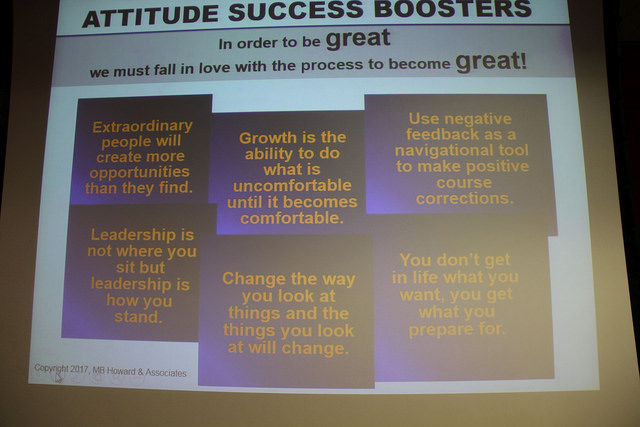|
|
|
Tuesday, September 17th, 2019

I’m frequently accused about being badly out-of-date with current terms, let alone trendy ones, but I find myself using them even when they make me uncomfortable. That’s the case with “talent,” a term I’ve used, although it makes me squirm. This post from Wally Bock does a great job of explaining why. (I never really thought it through.) Thanks, Wally!
I’m sick of “talent.” I’m sick of wars for talent, and talent pipelines, and talent acquisition. I’m sick of talent anywhere it’s used as a substitute for people. People are not talent. People have talent. People are more than talent.
There’s no such thing as disembodied talent. Every bit of talent comes wrapped up in flesh and blood people.
People Are More Than Talent
People aren’t just talent. They bring you their hopes and fears. They bring their experience, expertise, and passions. Sure, their talent is important, but so are other things.
Their work ethic is important. The other people on your team want to work with someone who pulls their own weight. If you’ve got a slacker, even a talented one, you’ve got a problem.
Social skills matter. Nobody wants to work with or for a jerk. If you’ve got a talented person who can’t get along with other people, you’ve got a problem.
The situation matters. Context is critical. Talent is specific. If you’ve got a talented person in the wrong job, you have a problem.
Let’s quit talking about talent as if it’s some disembodied thing that we can bottle or store or (gag) develop. Instead, let’s think of talent as one of the many parts of those complex and wonderful people we work with.
Image credit: Three Star Leadership
Posted in Hiring, Retention | No Comments »
Monday, September 24th, 2018

Poking through 11+ years of posts I find information that’s as useful now as when it was written.
Golden Oldies is a collection of the most relevant and timeless posts during that time.
You can not imagine the thrill when I see the stuff I passionately believe in mirrors the beliefs of people I hold in high regard, such as Fred Wilson, who knows and has experienced far more than I ever will. It’s a definite high.
Read other Golden Oldies here.
A few days ago Fred Wilson wrote about the importance of culture and fit.
Some entrepreneurs and CEOs buy into “hire the best talent available” mantra. That can work if everything goes swimmingly well. But as I said, it often does not, and then that approach is fraught with problems. The other approach is hire for culture and fit. That is the approach I advocate.
That’s the same approach I’ve advocated for decades.
What many forget is that “the best talent available” refers to whoever will perform best in your culture as part of your team and focus on your company’s success.
Too many founders, CEOs, other execs and even lower level managers seem to hire for bragging rights instead.
I wrote about hiring and culture here last Sept and included a link to an article I wrote for MSDN way back in 1999 that explained how to use your culture as a screening tool when hiring.
I’ve always told clients that the fastest way to success is to always hire the right person at the right time and for the right reasons.
Good hiring is like cooking Chinese—80% of the time used is spent prepping and the balance doing.
There really are no shortcuts; especially not hiring other people’s stars.
Not to sound self-serving, but I’ve been surprised at how closely the ideas I’ve always believed in parallel Wilson’s thoughts.
Image credit: HikingArtist
Posted in Golden Oldies, Hiring | No Comments »
Wednesday, February 21st, 2018

Yesterday we looked at the new methodology being used to determine Fortune’s 100 Best Places to Work, which has been tweaked to emphasize feedback from those who self-identified as women, minorities, or LGBTQ.
Hard data has proven over and over that a diverse leadership and workforce increases revenues, adding substantially to company revenues and success.
Companies have spent millions on diversity training, so why hasn’t it worked?
It shouldn’t be surprising that most diversity programs aren’t increasing diversity. Despite a few new bells and whistles, courtesy of big data, companies are basically doubling down on the same approaches they’ve used since the 1960s—which often make things worse, not better. Firms have long relied on diversity training to reduce bias on the job, hiring tests and performance ratings to limit it in recruitment and promotions, and grievance systems to give employees a way to challenge managers.
The answer is fairly obvious to anyone who considers people, instead of datasets, etc.
In short, people don’t like being told what to think/do.
As social scientists have found, people often rebel against rules to assert their autonomy. Try to coerce me to do X, Y, or Z, and I’ll do the opposite just to prove that I’m my own person.
Not exactly rocket science.
So what’s a successful approach?
It’s more effective to engage managers in solving the problem, increase their on-the-job contact with female and minority workers, and promote social accountability—the desire to look fair-minded.
Or in today’s terms, DIY
Maybe it is rocket science.
More proof that diversity is (finally) being taken seriously is found in a lawsuit recently filed by IBM.
Diversity hiring, once a niche pursuit of human resources, has become a major recruiting priority at many US companies. As evidence, IBM is suing its former chief diversity officer for bolting to Microsoft.
Diversity hiring as a trade secret.
I love it.
Image credit: US Forest Service – Southern Region
Posted in Business info | No Comments »
Friday, July 21st, 2017
A Friday series exploring Startups and the people who make them go. Read all If the Shoe Fits posts here.
 Do you believe that Silicon Valley is the best (only?) place to start a company? That there is some almost magical ingredient that isn’t duplicated anywhere else? Do you believe that Silicon Valley is the best (only?) place to start a company? That there is some almost magical ingredient that isn’t duplicated anywhere else?
Many people do and more did back in 2010.
Demis Hassabis, co-founder of high-flying DeepMind didn’t believe the myth.
“I was born in London and I’m a proud born and bred Londoner. I obviously visited Silicon Valley and knew people out there and also I’d been to MIT and Harvard and seen the East Coast. There is this view over there that these kind of deep technology companies can only be created in Silicon Valley. Certainly back in 2010 that was definitely the prevailing view. I felt that that just wasn’t true.”
Investor Peter Thiel was one of the true believers.
“At that time he’d never invested outside of the US, maybe not even outside of the West Coast. He felt the power of Silicon Valley was sort of mythical, that you couldn’t create a successful big technology company anywhere else. Eventually we convinced him that there were good reasons to be in London.”
Hassabis convinced Thiel to invest; Google acquired it for $400 million, and DeepMind is still making AI history.
One of the major reasons Hassabis wanted to stay in London was the availability of incredible talent.
“One of the things was I thought it [staying in London] was going to be a competitive advantage in terms of talent acquisition,” said Hassabis. He went on to claim that there weren’t that many intellectually stimulating jobs for physics PhDs out of Cambridge at the time that didn’t want to work for a hedge fund in the city.
Unlike Silicon Valley which, in addition to its normal talent shortage, suffers a severe talent crunch in whatever tech is hottest.
Silicon Valley may be a great place to start a company if you are connected, but for the majority who aren’t there are plenty of locations that are just as good, if not better.
Of course, that depends on whether your goal is to found a company valued for funds raised, which is best done in Silicon Valley, or to found a company that is valued on actual revenue, which can be done anywhere.
In fact, for the latter, anywhere could even be preferable to Silicon Valley.
Image credit: HikingArtist
Posted in Hiring, If the Shoe Fits, Innovation | No Comments »
Tuesday, November 15th, 2016

I read an interesting article about hard work vs talent by Ed Latimore.
For those of you (like me) who never heard of Ed Latimore, he is a boxer (12-0 w/7 KOs), who also writes books and is a motivational speaker.
Take a minute to read the whole thing, but here is the most important take-away.
If you have nothing particularly special about your mind or body, you always have hard work. The ability to work your ass off is underrated as a talent because we consider talent something special, unique, and largely unteachable. (…) working your ass off is a talent you can learn.
Along with hard work, you need to develop your initiative.
Initiative is a muscle and you have dozens of opportunities to exercise it every day.
It’s simple.
Anything you notice, large or small, that needs to be done, do it.
That’s all.
Do it and initiative becomes a habit, just like hard work.
And I can pretty much guarantee that those two habits will take you almost anywhere you want to go.
Image credit: Ralf Peter Reimann
Posted in Ducks In A Row, Personal Growth | No Comments »
Monday, September 12th, 2016
It’s amazing to me, but looking back over more than a decade of writing I find posts that still impress, with information that is as useful now as when it was written. Golden Oldies is a collection of what I consider some of the best posts during that time.
Companies are fond of calling those who toil for them by different names. ‘Human resources’, which morphed to just ‘resources’ was one of the first. Then came ‘talent’. Next, the pendulum swung back to ‘people’. Managers, on the other hand, have always talked about their ‘people’. But no matter what the company or manager called them, they were individuals; each with different skills, goals and passions — and need to be managed as such.
Read other Golden Oldies here.
 Do you work for a company or a manger? Do you work for a company or a manger?
If you ask most people who they work for they’ll name a company, but if you ask them why they love or hate it, stay or leave, they’ll usually mention a manager, the people or the culture, which is a projection of the manager and the people.
People quitting is expensive and bad for team morale, but having them quit and not leave is the worst thing that can happen.
Think about it, who do you manage? And How?
Adequate managers manage employees.
Good managers manage people.
Great managers manage persons.
Yes, persons.
Individuals, because you can’t manage (or lead) everyone the same way.
The same words often mean something different to different people, so you need to say what’s necessary in whatever words will ensure that each individual hears and understands your message.
I’m not saying that it’s easy, but you aren’t paid for easy—you’re paid for results.
And knowing how to manage persons is the best way to ensure that your people won’t quit.
Image credit: ZedBee|Zoë Power on flickr
Posted in Golden Oldies, Personal Growth, Retention | 3 Comments »
Tuesday, November 3rd, 2015

In one way or another, I’ve been involved in staffing for more than 30 years; first as a recruiter, then as a coach and mentor.
I’ve worked with companies from earliest startups to Fortune 500; with bosses ranging from CEOs and other executives to first-line supervisors and team leaders.
The best and smartest companies/bosses never have an opening and almost never lay people off — the ‘almost’ being directly connected to the the bosses’ level of control within the company.
How they accomplish this is often a mystery to outsiders, but it’s simply the result of specific MAP (mindset, attitude, philosophy™).
I’ve listen to many bosses tell me why this approach wasn’t feasible, often using their industry as the reason.
Most of the ‘reasons’ fall apart when you consider Intuitive Research & Technology, which has never laid off an employee.
That’s impressive for any company, but it’s especially notable for a 16-year-old aerospace engineering and analytics firm that’s a contractor for the federal government.
Intuitive also never has job openings.
Harold Brewer, Intuitive’s co-founder, chairman, and president, says the company has avoided reductions by taking a unique approach to hiring. “We don’t really have job openings,” he says. Instead, the company operates like a talent agency—always scouting for skilled employees. (…) Brewer calls it a “speculation hire.”
His mantra is simple, “If it’s good for employees, it’s good for business,” so the company supports training, advanced education (unlimited tuition reimbursement) and pays substantial bonuses.
It’s what I’ve always said, hire great talent, instead of filling openings, cherish them, so they stay and watch your organization prosper.
Flickr image credit: Serena
Posted in Ducks In A Row, Hiring, Retention | No Comments »
Wednesday, October 28th, 2015

Monday we considered the idea that a team can have too much talent, i.e., stars.
Bosses claim they hire stars because they are the rocket that drives a team further, faster.
I think many do it because they are lazy.
As Wally Bock puts it, “We live in a world of microwavable answers and quick fixes” — and bosses see stars as quick fixes.
Which, if you will excuse the bluntness, is really stupid for two reasons.
The so-called slow fix takes more effort, but provides far greater ROI.
And you, personally, do much better, and have more fun, with fewer regrets, building your own team of stars — usually the only things lacking in this approach are egos, prima donnas and drama.
A slightly offbeat story illustrates the kind of stars that can result.
Faculty from Bard College coach a debate team from the Eastern New York Correctional Facility, a maximum-security lockup.
They recently beat the national and world champion Harvard team. They have also beaten the University of Vermont and West Point teams.
They are home-grown stars, since it’s doubtful that a world-class team of debaters were all incarcerated at the same facility.
The point of all this is that if you want to be known as a great boss, then be the coach who builds an extraordinary team, as opposed to being the one who hires shooting stars.
Flickr image credit: Michael Pollack
Posted in Hiring, Motivation, Retention | 1 Comment »
Friday, April 3rd, 2015
A Friday series exploring Startups and the people who make them go. Read all If the Shoe Fits posts here
 Founder: I can’t be a good leader without knowing my people. How I can contribute to their life? Founder: I can’t be a good leader without knowing my people. How I can contribute to their life?
Me: You are going to have a lot of people who have no interest in sharing their personal life with you or having you contribute to it other than providing a great place to work.
Founder: How? I am a leader who prefers 1 on 1
Me: It’s not about you, it’s about them and what interaction they prefer; and as the company grows you will not have time or access for 1/1, unless you plan to interfere with your managers’ organizations. What it is about is the culture you create.
Founder: You can’t lead if you can’t connect.
Me: Connection is not always 1/1; that’s why culture is so important.
Founder: You have to know your people.
Me: No, you need to know your direct reports and know that they are supporting your culture. Anyway, good leadership should be spread around your company and not just the province of certain positions.
Founder: You can’t convince me. I have had coffee with my subordinates to know them and that catapulted us. Culture is about having a tea, cappuccino with my subordinates and talking about stuff, then car-pooling.
Me: I’m not saying to stop, I’m saying it won’t work with everyone, plus, you won’t have time as the company grows. There are many people who have no interest in that kind of intimate, personal relationship with their boss, but are world-class hires. They care about the company’s culture because they know it reflects the founder’s values.
Me: Moreover, bosses who can only relate 1/1 are often seen as playing favorites, because they tend to favor those who respond to their approach.
Me: If you try to cram every hire into any one, narrow MAP it will cost you talent and engagement, because those who don’t like it will either walk or disengage.
Me: The important takeaway here is that when it comes to worker interaction one size does not fit all.
Image credit: HikingArtist
Posted in Hiring, If the Shoe Fits, Personal Growth | 1 Comment »
Thursday, December 26th, 2013
No matter the job market, founders go on and on about the lack of the right talent for their needs.
I, on the other hand, and others like me, keep saying that attitude is more important than skills.
Want proof?
OK, answer this question.
If you were a basketball coach would you want a one-handed player?
No?
Boy, is that a bad assumption-based decision.
Kind of like assuming that skills are age or school-based.
YouTube credit: ScoutsFocus.com
Posted in Entrepreneurs, Hiring | No Comments »
|
 Subscribe to
Subscribe to
MAPping Company Success
About Miki 
Clarify your exec summary, website, etc.
Have a quick question or just want to chat? Feel free to write or call me at 360.335.8054
The 12 Ingredients of a Fillable Req
CheatSheet for InterviewERS
CheatSheet for InterviewEEs™
Give your mind a rest. Here are 4 quick ways to get rid of kinks, break a logjam or juice your creativity!
Creative mousing
Bubblewrap!
Animal innovation
Brain teaser
The latest disaster is here at home; donate to the East Coast recovery efforts now!
Text REDCROSS to 90999 to make a $10 donation or call 00.733.2767. $10 really really does make a difference and you'll never miss it.
And always donate what you can whenever you can
The following accept cash and in-kind donations: Doctors Without Borders, UNICEF, Red Cross, World Food Program, Save the Children
*/
?>About Miki
About KG
Clarify your exec summary, website, marketing collateral, etc.
Have a question or just want to chat @ no cost? Feel free to write
Download useful assistance now.
Entrepreneurs face difficulties that are hard for most people to imagine, let alone understand. You can find anonymous help and connections that do understand at 7 cups of tea.
Crises never end.
$10 really does make a difference and you’ll never miss it,
while $10 a month has exponential power.
Always donate what you can whenever you can.
The following accept cash and in-kind donations:
|







 Do you believe that Silicon Valley is the best (only?) place to start a company? That there is some almost magical ingredient that isn’t duplicated anywhere else?
Do you believe that Silicon Valley is the best (only?) place to start a company? That there is some almost magical ingredient that isn’t duplicated anywhere else?
 Do you work for a company or a manger?
Do you work for a company or a manger?


